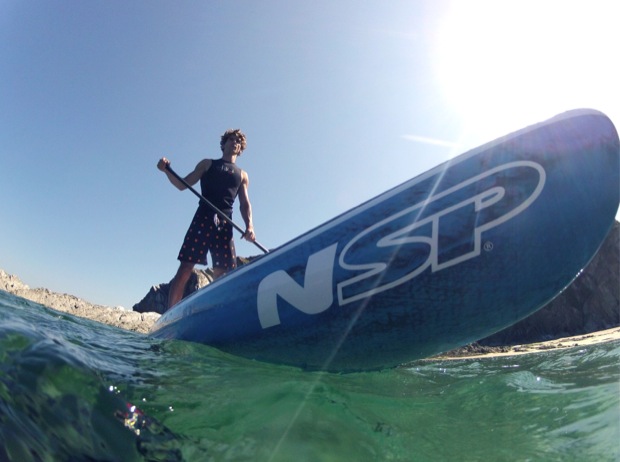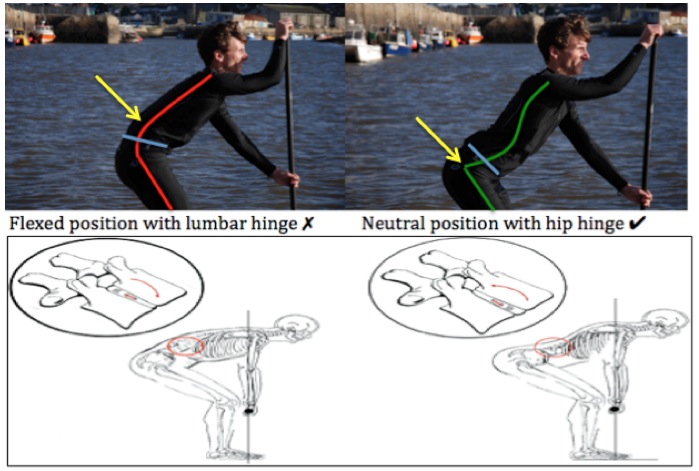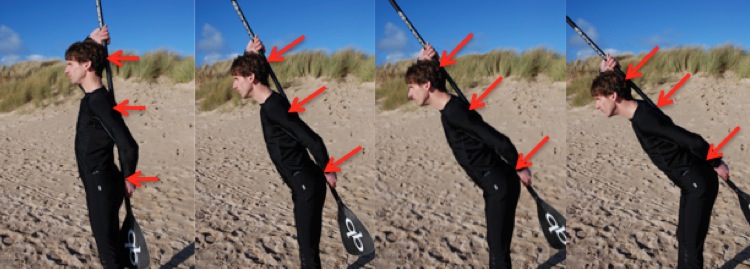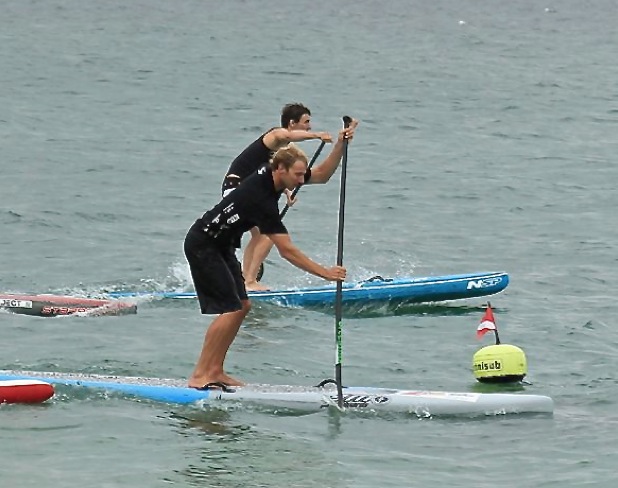
How does this relate to SUP?
The natural design of human biomechanics allows us to bend forwards. SUP technique requires an element of bending forwards to produce the maximum power delivery though the paddle itself.
The key to reducing lower back injuries caused by SUP is pelvic tilt. If forward bending is done with a neutral posture (lumbar lordosis) then the strain on the lower back will be minimal and less likely for injuries to occur. If pelvic control is poor and the pelvis is tilted backwards, the hinge point (yellow arrow) comes from the lumbar spine rather than the hip, which leads to injuries.

The blue line shows the top of the pelvis. If the pelvis tilts forwards the hips flex more than the lower back, and the natural lumbar curve is maintained. The hip joints are also much better designed to take the forces involved.
How can I reduce the risk of getting lower back injuries?
1. Have a think about your posture whilst paddling. Can you maintain a neutral lumbar spine position? Take your paddle and hold it against your back. Try and keep 3 points of contact on the paddle whilst bending forwards (Red arrows in the pic below).
– At the sacrum – the boney bit at the base of your spine.
– The mid-thoracic spine – between your shoulder blades.
– The back of your head.

Bend forwards with the paddle and keep all three points in contact with the paddle (Pelvis tilts forwards and bend at the hips).
2. Work on strengthening off the water… A lot of people think that SUP boarders have “good core stability” and therefore strong around the lumbar spine. In some ways this may be true, but it’s actually irrelevant unless you are engaging the correct muscle structures and developing the correct motor control (learned movement pattern). This video shows Annabel Anderson demonstrating some great strengthening exercises, which will help develop correct movement patterns with a neutral lumbar spine posture. I will write about strengthening and core stability in greater detail soon.
3. Adapt according to conditions so you don’t strain your lower back. Try to maintain a natural lumbar curve even when there is a lot of swell, choppy or windy… and especially when you are becoming fatigued. Whilst surfing this is even more difficult. Some people favour a shorter paddle, which means you are more inclined to bend at the waist.

A good example of this is British Champ Ollie Shilston’s technique. He adapts efficiently in bad conditions by shortening his stroke, altering stroke rate and absorbing force at the hips and knees, NOT flexing the lower back to maintain stroke efficiency.
4. Flexibility… I know stretching is often the last thing you want to do when you could be on the water. But if a muscle group that attaches to the pelvis is tight (hamstrings, hip flexors, lumbar extensors and abdominals), it can alter pelvic mobility, which could impact on your lower back. Include major muscle group stretches in a warm-up/cool down as a minimum. I will also try and discuss this and the kind of things to look out for soon.
5. Don’t be lazy when lifting your board… Too obvious to even mention? Probably, but a 15 kg board puts enough force through the lumbar spine to cause a disc injury.
Next time I hope to cover low back injuries part 2 – Stretching and Strengthening. Thanks for reading. Damo
Please remember : Spinal anatomy and back pain in general is complex. This article is intended to give readers some awareness only, and not to be used for self-diagnosis or a substitute for professional advice. If you have low back pain, associated pins and needles/numbness between your legs, changes in bladder/bowel function, unexplained weight loss, leg weakness or progressively worsening symptoms seek urgent medical advice.
Incase you missed Damian’s first article about common SUP related shoulder injuries you can check it out here.

You tell to don’t “snake “…the spine and after show a video of a really poor technique knees and with a snaky back during simple squat exercises…!(as you can see her doing in lateral position….!!!)..
Brilliant article and great advice. I’ve been waking up with lower and mid back pain regularly. So going to try these, thanks guys
The picture of the spine really only tells part of the story… you should see how the muscles are all interconnected as well. A lot of the time when someone has back pain it’s not even a spinal issue, it’s a muscular imbalance of some kind. For example, tight glutes pulling on the lower back causing pain. Not the kind of thing most people expect!